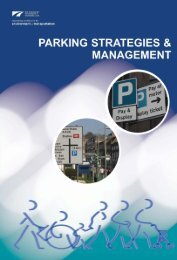Level 2 and 3 Diploma in Business Support (4475-12/13)
Level 2 and 3 Diploma in Business Support (4475-12/13)
Level 2 and 3 Diploma in Business Support (4475-12/13)
You also want an ePaper? Increase the reach of your titles
YUMPU automatically turns print PDFs into web optimized ePapers that Google loves.
A USO – Unique Service Offer is what makes a service different or better from its competitor(s) eg<br />
24 hour availability. A USO is used to differentiate a service offer from that of competitors or<br />
comparable organisations. USOs are directly related to why customers choose to do bus<strong>in</strong>ess<br />
with organisations by us<strong>in</strong>g their products or services. Customers buy benefits <strong>and</strong> solutions NOT<br />
products <strong>and</strong> the c<strong>and</strong>idate should be familiar with the technique of sell<strong>in</strong>g features <strong>and</strong> benefits<br />
<strong>and</strong> should know how these compare with those of competitors.<br />
USPs <strong>and</strong> USOs are used to differentiate what one organisation provides by way of products<br />
<strong>and</strong>/or services from another.<br />
1.9 Keep<strong>in</strong>g up-to-date with product <strong>and</strong> services knowledge is vital. Various sources of <strong>in</strong>formation<br />
about products <strong>and</strong>/or services will be available with<strong>in</strong> an organisation eg catalogues, brochures,<br />
price lists, colleagues, <strong>in</strong>ternet, <strong>in</strong>tranet, tra<strong>in</strong><strong>in</strong>g sessions, organisational product <strong>and</strong>/or service<br />
<strong>in</strong>formation/literature, word of mouth from customers.<br />
1.10 Promotion methods can be leaflets, telephone call<strong>in</strong>g, demonstrations, mailshots, promotional<br />
videos, newspaper (national <strong>and</strong> local) advertisements, television advertisements, local/national<br />
radio advertisements. Organisations need to promote benefits not features.<br />
Outcome 2 Underst<strong>and</strong> how customer needs <strong>and</strong> expectations are<br />
formed<br />
2.1 Organisation’s service offer - also known as a customer charter – is the organisation’s statement<br />
about the level of service they will offer eg some customer charters will set out how they will<br />
compensate a customer when customer service has not been delivered <strong>in</strong> l<strong>in</strong>e with the charter;<br />
or it will clearly stated the timescales for responses. The service offer sets the basis on which the<br />
organisation will provide a service to its customers. Customers will know this is what they can<br />
expect while organisations know what they must deliver.<br />
2.2 Customer expectations are what customers th<strong>in</strong>k should happen <strong>and</strong> how they believe they<br />
should be treated when ask<strong>in</strong>g for or receiv<strong>in</strong>g customer service. Expectations are formed eg<br />
• through what customers hear <strong>and</strong> see<br />
• what they read <strong>and</strong> the messages the organisation sends (ie via its reputation <strong>and</strong> br<strong>and</strong>)<br />
• what actually happens to them when deal<strong>in</strong>g now <strong>and</strong> <strong>in</strong> the past with an organisation.<br />
Customer expectations are also heavily <strong>in</strong>fluenced by word of mouth (eg friends <strong>and</strong> family) <strong>and</strong><br />
also the media. Customers may have experiences with similar organisations which impact upon<br />
their overall impression <strong>and</strong> expectations of that particular service <strong>in</strong>dustry, eg hotels <strong>and</strong><br />
restaurants, supermarkets, bank<strong>in</strong>g, <strong>in</strong>surance.<br />
2.3 Customer service equals the totality of what an organisation does to meet customer<br />
expectations <strong>and</strong> produce customer satisfaction. Customer expectations are what customers<br />
th<strong>in</strong>k should happen <strong>and</strong> how they believe they should be treated when ask<strong>in</strong>g for or receiv<strong>in</strong>g<br />
customer service. Customer satisfaction then occurs when a customer is happy with the service<br />
provided. However, it is not sufficient for some organisations to simply achieve customer<br />
satisfaction; they want to do better <strong>and</strong> talk <strong>in</strong> terms of exceed<strong>in</strong>g customer expectations,<br />
delight<strong>in</strong>g the customer or surpris<strong>in</strong>g the customer. Customer satisfaction is still achieved but the<br />
perception is to a greater degree.<br />
2.4 Customer needs can be identified through the use of well-developed <strong>in</strong>ter-personal skills which<br />
enable a service deliverer to accurately identify those needs. Customers at times do not have a<br />
clear underst<strong>and</strong><strong>in</strong>g of their needs. Assist<strong>in</strong>g <strong>in</strong> determ<strong>in</strong><strong>in</strong>g needs is a valuable service to the<br />
customer <strong>and</strong> this can be done by ask<strong>in</strong>g the customer relevant questions <strong>and</strong> listen<strong>in</strong>g carefully<br />
to what the customer’s responses are.<br />
2.5 Customer feedback is what the customer reports back to an organisation about the customer<br />
service experienced. It may be collected by the organisation formally us<strong>in</strong>g questionnaires,<br />
comment cards, competitions, focus groups or surveys (telephone or mail). This is sometimes<br />
90 <strong>Level</strong> 2 <strong>and</strong> 3 <strong>Diploma</strong> <strong>in</strong> Bus<strong>in</strong>ess <strong>Support</strong> (<strong>4475</strong>-<strong>12</strong>/<strong>13</strong>)







